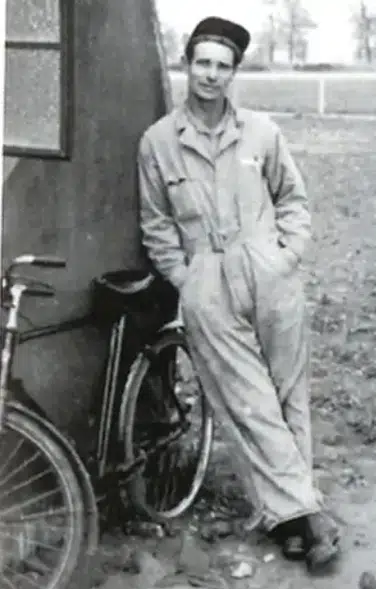Eighty years ago a 32-year-old Odin man was declared missing in action after his ‘Wing Dinger’ B-24 Liberator did not return to the Allied airfields in Libya.
Tech. Sgt. Harold Kretzer was one of 225 Airmen lost along with 51 B-24 Liberators during Operation Tidal Wave where the United States and its Allies were trying to starve the Nazi war machine of the fuel it needed to continue to terrorize the world. He was among those whose remains could not be identified and he was buried as an “unknown” first in Romania where his plane went down and then after the war ended he was transferred to an American cemetery in Belgium.
On June 2, Kretzer of Odin, Illinois, will be MIA no longer. At 1 p.m. at Camp Butler National Cemetery in Springfield, Illinois, he will be interred among his brethren from many different wars and conflicts. Tech. Sgt. Kretzer will be home.
Kretzer’s grandniece Glenda Thomas says they appreciate the effort of the U.S. Department of Defense to bring Uncle Harold home after 80 years and its continued effort to identify and bring others home no matter how much time has passed. She is also grateful to the many veterans organizations who tirelessly advocate for those who have served in this nation’s wars.
Thomas said eight decades have dimmed personal memories of her uncle. His mother, Mae Kretzer, was living in Harvey, Illinois, in Cook County when Harold’s bomber crashed. She has long since passed and there are very few around now who knew him. But the family has taken pride in knowing one of their own served our country honorably and gave his life to preserve our freedoms against tyranny.
The Kretzer family has decided to keep his memorial services private, but his burial services at Camp Butler will be open to the public.
According to the U.S. military’s Defense POW/MIA Accounting Agency (DPAA), Kretzer was officially accounted for on Aug. 23, 2022.
The further effort to identify the unknown began in 2017 when the accounting agency began exhuming unknowns believed to be associated with unaccounted-for airmen from Operation Tidal Wave losses. These remains were sent to the DPAA Laboratory at Offutt Air Force Base, Nebraska, for examination and identification.
To identify Kretzer’s remains, scientists from DPAA used anthropological analysis, as well as circumstantial evidence. Additionally, scientists from the Armed Forces Medical Examiner System used mitochondrial DNA (mtDNA) and Y chromosome DNA (Y-STR) analysis – DNA from Kretzer’s mother’s side of the family and father’s side of the family – to confirm his identity.
Kretzer’s name is recorded on the Wall of the Missing at Cambridge American Cemetery, an American Battle Monuments Commission site in Cambridge, United Kingdom, along with others still missing from World War II. A rosette will be placed next to his name to indicate he has been accounted for.
At 32, Kretzer was five years older than the average World War II service member. As a World War II technical sergeant, he was a senior noncommissioned officer equal in rank to today’s Army sergeant first class or Air Force master sergeant.
Kretzer was the Wing Dinger’s gunner-engineer in the B-24 Liberator’s crew of eight during Operation Tidal Wave. The operation was designed as the first large-scale, low-altitude attack by U.S. heavy bombers. Flying only 100 to 300 feet above the ground, the objective was to destroy Ploiești oil refineries. Romania produced 60 percent of Nazi Germany’s crude oil supplies and an estimated 27 to 35 percent of its refined or synthetic oil. The most important refineries were those surrounding Ploiesti in southeast Romania near Bucharest.
The bombing was successful but costly. The Germans defending the refineries were ready and waiting for the American bombers.
Barrage balloons tethered with metal cables hovered over Ploiesti to impede the flight of the American bombers and tear into their aluminum sides. The Germans opened smoke pots in the surrounding fields and set oil tanks around the refineries aflame, sending up dense clouds of black smoke to blind the pilots. They placed anti-aircraft guns along the railroad tracks, among the oil tanks, and in the fields outside of town. As the Liberators approached Ploiești, German ground defenses unleashed an intense hail of 37mm anti-aircraft and machine gun fire at the low-flying aircraft.
The last moments of Tech. Sgt. Kretzer’s life was violent and chaotic but his actions and willingness to serve – and the actions of millions of others like him – led to the defeat of a dangerous dictatorship bent on world domination. For his actions, Kretzer was awarded Distinguished Flying Cross, Purple Heart, Air Medal with one Bronze Oak Leaf Cluster, Army Good Conduct Medal, European-African-Middle Eastern Campaign Medal with three Bronze Service Stars, World War II Victory Medal, Presidential Unit Citation with one Bronze Oak Leaf Cluster, U.S. Army Air Force Flight Engineer Wings Badge, and Honorable Service Lapel Button – World War II.
DPAA has now identified more than half of the 80 unknowns associated with Operation Tidal Wave.
Information for this story was provided by the Illinois National Guard.


